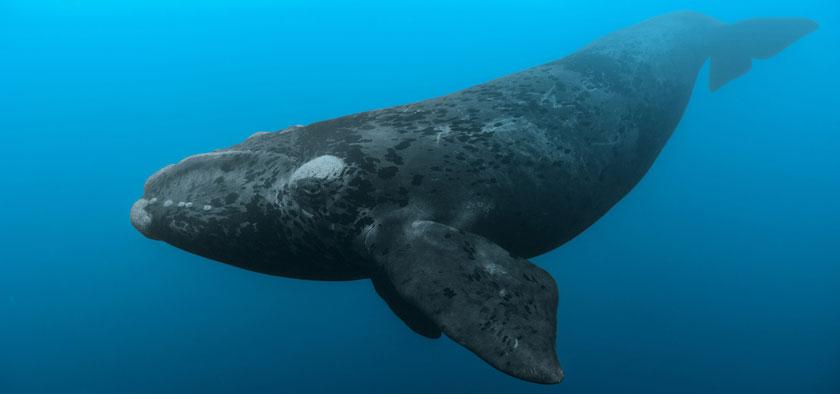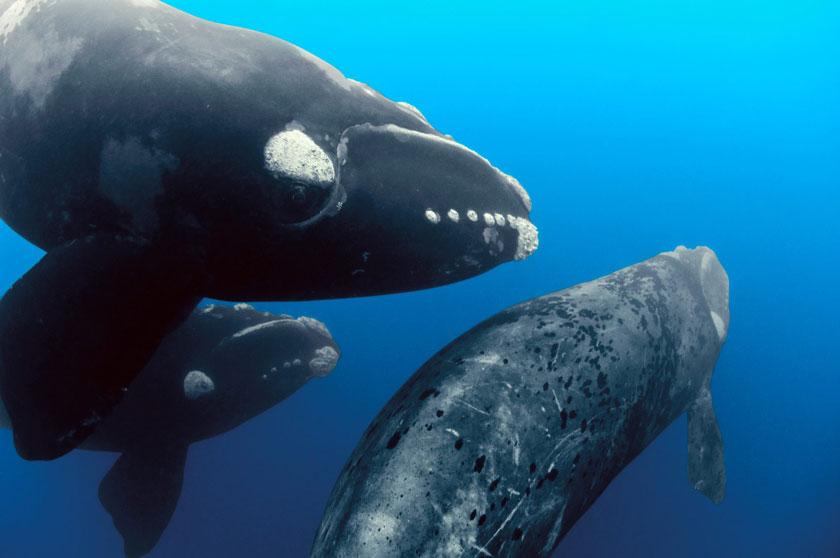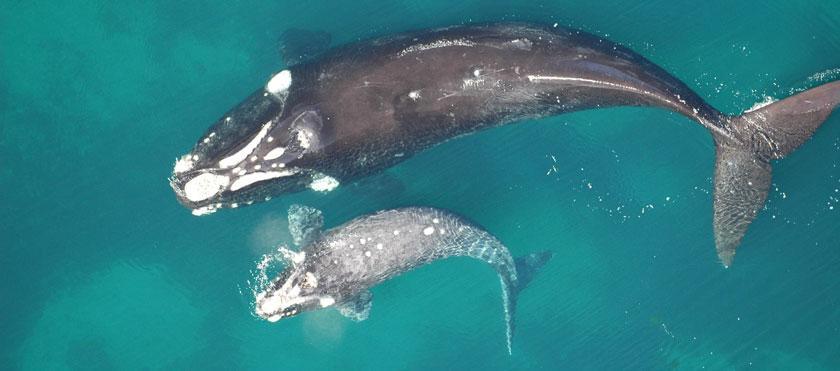Facts about Southern Right Whales
Each year Southern Right whales migrate into the coastal waters of Hermanus in the Western Cape to calve and nurse their young. The animals, often mere metres from the shore, provide unsurpassed whale watching opportunities between June and November. Humpbacks migrate through the region between May and December each year, while Bryde's whales are found slightly further offshore all year round.

Image above courtesy of New Zealand Geographic
It has very dark grey or black skin, with occasional white patches on the belly. Its two separate blow holes produce a distinguishing V-shaped blow. Southern rights have an enormous head which is up to one quarter of total body length. The callosities on the head are made of hard material, similar to human finger-nails, which appear white due to large colonies of whale lice called cyamids. The number, shape and position of the callosities are unique to each individual whale, and allow us to tell them apart. Southern right whales tend to have a large callosity at the front of the head, called a ‘bonnet’.
Southern Right Whales are easily distinguished from the other 2 baleen whales ( Humpback & Bryde’s whales ) by three distinct characteristics:
- V-shaped blow,
- callosities on their heads
- and the lack of a dorsal fin on their broad backs.
Southern Right Whales can reach a maximum length of 15-17 meters and can weigh 50 – 60 tons. They have broad black tails and squarish flippers.

Image above courtesy of New Zealand Geographic
The callosities on the jaws and are wart-like bumps are called a bonnet and are home to specialized whale lice and barnacles.
Southern right whale Whales tend to show in the following Behaviour:
- Blowing: A sound made when expelling air through the blowhole. This is accompanied by a spout of condensed water vapour. This however is the normal breathing pattern of the animal.
- Breaching: Leaping out of water in an arching backflip and falling back on their sides or back with a resounding slap. This is believed to be a way of communication, exercise or possibly to scratch the parasites off that live on whales. They can breach form 3 to 8 times in succesion.
- Lobtailing: The slapping of flukes and tail on the water, causing a loud sound, appears to be a means of communication.
- Spy hopping: The head and body are lifted vertically, as far as the flippers, above the surface. This enables them to see what is happening around them above water.
- Mating groups are often associated with increased activity, with the female rolling over and slapping her flippers on the surface, trying to avoid the males. As many as 6-10 males might be trying to mate with one female.

Image above courtesy of De Hoop Collection
Life History
Females give birth to their first calf at about 8-10 years old.
Southern right whale females have their first calf between 7 - 10 years of age, and they then have one calf every three years. They are very slow breeders.
Gestation period is up to 1 year. (10 - 12 months)
Calving is normally a 4 month period, peaking around August. The calf is born tail first at a rapid pace to allow the newborn to surface and take in the air as soon as the umbilical cord breaks. The calf will suckle on milk till they reach a size of approx 8.5m. At birth they measure 5-6m.
Female southern right whales usually come back to the very same coastal embayment to raise each calf, often the bay where they themselves were born…but occasionally, they can swap calving areas
Diet The primary food source for southern right whales is zooplankton (e.g., copepods and krill). Unlike other baleen whales, right whales are skimmers: they feed by removing prey from the water using baleen while moving with their mouth open through a patch of zooplankton.
The primary food source for southern right whales is zooplankton (e.g., copepods and krill). Unlike other baleen whales, right whales are skimmers: they feed by removing prey from the water using baleen while moving with their mouth open through a patch of zooplankton.
There are estimated to be about 3 000 - 4 000 southern right whales at present, with South Africa receiving the major percentage visiting its coasts annually.
Experience the thrill of watching these gentle giants of the deep close up, by taking a 2-hour boat based whale-watching trip. Click to Check availability and book online
Source
IMAGES:
- New Zealand Geographic
- National Geographic
- De Hoop Collection
- Wikipedia
TEXT:
- National Geographic
- Wild about Whales
- WDC
- NOAA Fisheries
- Wikipedia
Call us and schedule your listing today! Contact Us
Copyright © 2024 Hermanus Online Magazine. Web Development by Jaydee media.

